Limitations of Smart Cruise Control
Smart Cruise Control may have limits to its ability to detect distance to the vehicle ahead due to road and traffic conditions.
Driving on a curved road
-
On curves, Smart Cruise Control may not detect a moving vehicle in your lane, and then your vehicle could accelerate to the set speed. Also, the vehicle speed will rapidly slow down when the vehicle ahead is recognized suddenly.
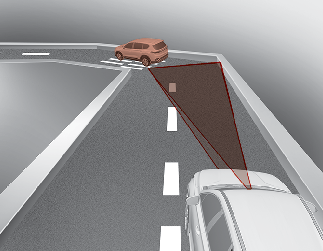
-
Select the appropriate set speed on curves and adjust your vehicle speed by depressing the accelerator or brake pedal according to the road condition ahead and driving condition.
-
Your vehicle speed can be reduced due to a vehicle in the adjacent lane. Adjust your vehicle speed by depressing the brake pedal according to the road condition ahead and driving condition. Apply the accelerator pedal and select the appropriate set speed. Check to be sure that the road conditions permit safe operation of Smart Cruise Control.
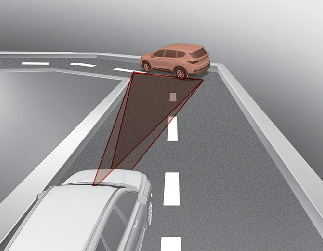
Driving on a sloped road
-
During uphill or downhill driving, Smart Cruise Control may not detect a moving vehicle in your lane, and cause your vehicle to accelerate to the set speed. Also, the vehicle speed will rapidly down when the vehicle ahead is recognized suddenly.
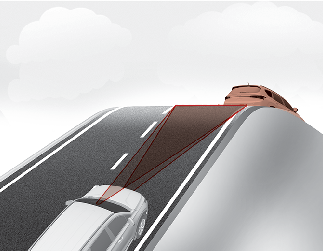
-
Select the appropriate set speed on inclines and adjust your vehicle speed by depressing the accelerator or brake pedal according to the road condition ahead and driving condition.
Changing lanes
-
A vehicle which moves into your lane from an adjacent lane cannot be recognized by the sensor until it is in the sensor's detection range.
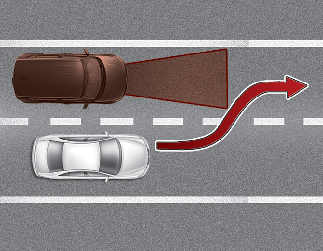
-
The sensor may not detect immediately when a vehicle cuts in suddenly. Always pay attention to the traffic, road and driving conditions.
-
If a vehicle which moves into your lane is slower than your vehicle, your speed may decrease to maintain the distance to the vehicle ahead.
-
If a vehicle which moves into your lane is faster than your vehicle, your vehicle will accelerate to the selected speed.
-
Your vehicle may accelerate when a vehicle ahead of you disappears.
-
When you are warned that the vehicle ahead of you is not detected, drive with caution.
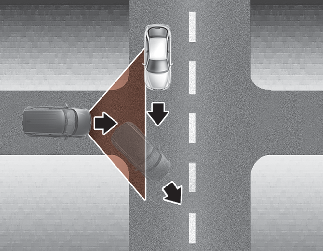
Recognizing the vehicle
Some vehicles ahead in your lane cannot be recognized by the sensor as follows:
-
Narrow vehicles such as motorcycles or bicycles
-
Vehicles offset to one side
-
Slow-moving vehicles or suddendecelerating vehicles
-
Stopped vehicles
-
Vehicles with small rear profile such as trailers with no loads
A vehicle ahead cannot be recognized correctly by the sensor if any of following occurs:
-
When the vehicle is pointing upwards due to overloading in the trunk(tailgate)
-
While making turns by steering
-
When driving to one side of the lane
-
When driving on narrow lanes or on curves
Adjust your vehicle speed by depressing the brake pedal according to the road condition ahead and driving condition.
-
When vehicles are at a standstill and the vehicle in front of you changes to the next lane, be careful when your vehicle starts to move because it may not recognize the stopped vehicle in front of you.
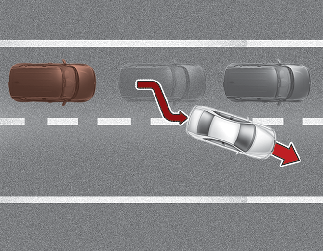
In this case, you must maintain a safe braking distance, and if necessary, depress the brake pedal to reduce your driving speed in order to maintain a safe distance.
-
Always look out for pedestrians when your vehicle is maintaining a distance with the vehicle ahead.
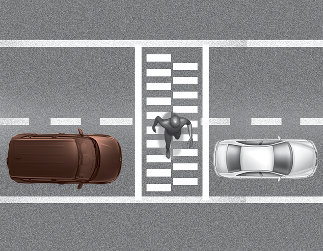
-
Always be cautious for vehicles with higher height or vehicles carrying loads that sticks out to the back of the vehicle.
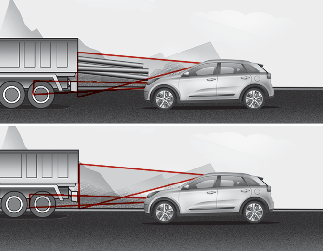

-
Smart Cruise Control cannot guarantee the stop for every emergency situation.
If an emergency stop is necessary, you must apply the brakes.
-
Keep a safe distance according to road conditions and vehicle speed. If the vehicle distance is too close during a high-speed driving, a serious collision may result.
-
Smart Cruise Control cannot recognize a stopped vehicle, pedestrians or an oncoming vehicle. Always look ahead cautiously to prevent unexpected and sudden situations from occurring.
-
Smart Cruise Control may have difficulty in maintaining the correct distance or speed, if the vehicle is driving on a steep incline or towing a trailer.
-
When other vehicles are changing lanes in front of you frequently, Smart Cruise Control may not operate appropriately. Always look ahead cautiously to prevent unexpected and sudden situations from occurring.
-
Smart Cruise Control is not a substitute for safe driving practices but a convenience function only. It is the responsibility of the driver to always check the speed and the distance to the vehicle ahead.
-
Always be aware of the selected speed and vehicle distance.
-
Always maintain sufficient braking distance and decelerate your vehicle by applying the brakes if necessary.
-
As Smart Cruise Control may not recognize complex driving situations, always pay attention to driving conditions and control your vehicle speed.
-
For safe operation, carefully read and follow the instructions in this manual before use.
-
While other warning sound is played such as not fastening the seat belt, Smart Cruise Control warning sound may not occur.
-
When driving with Smart Cruise Control set speed it may be possible that a vehicle which is parked ahead is not detected. Be careful if you fully rely on Smart Cruise Control function in such case, you may encounter a risk of collision.
-
Please turn off Smart Cruise Control while towing.
-
If the vehicle ahead disappears while driving and maintaining the set distance, the vehicle may accelerate until it reaches to set speed. Be careful for a possible dangerous situation.
-
When driving on a slippery road, be careful for possible dangerous situations.
-
Beware of dangerous situations as you may quickly pass vehicles driving in the next lane.
 CAUTION
CAUTIONSmart Cruise Control may not operate temporarily due to electrical interference.